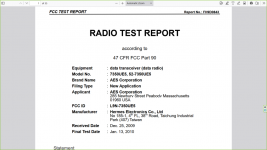bcoleman1
Member
Hi Hope all is well. query on any good online course or portal for repairing 5 watt radio transceiver units please?
I am researching online at present and found a good repair course on Udemy website for electronic repairing units, however
I am trying to find a course, online or part-time in Dublin on repairing radio transceiver units.
e.g. need to know how to fix the following:
1) no tx, no rx
2) tx stuck in low power
3) pa issues on pa component
4) vco or voltage issue no volts
Units are AES model 7350 and are used as fire and intruder alarm units on a radio mesh network.
appreciate any help or support please/
Thank you.
I am researching online at present and found a good repair course on Udemy website for electronic repairing units, however
I am trying to find a course, online or part-time in Dublin on repairing radio transceiver units.
e.g. need to know how to fix the following:
1) no tx, no rx
2) tx stuck in low power
3) pa issues on pa component
4) vco or voltage issue no volts
Units are AES model 7350 and are used as fire and intruder alarm units on a radio mesh network.
appreciate any help or support please/
Thank you.


